Part One • Part Two • Part Three • Part Four • Part Five • Part Six • Part Seven
NICEY: Freddie was my most glorious introduction to pop. I remember the morn after the show, I got up and looked at myself in the mirror and said: “Mate, you’re a great bloke. You really are a great bloke. Open your gorgeous eyes and look. Pop’s here. Look, I pondered to myself, look, you great big beautiful blue-eyed lovely man. You were put ‘pon this earth to be one of the world’s great philosophers. To teach people about the meaning-of-life-type stuff. To show ’em how to make a curious sense of this crazy-world-in-which-we-live-in-type scenario. With pop as your vehicle1, you can speak to the nation. For that is your purpose.”
Nicey belches.
What is the most memorable part of Smashie and Nicey: the End of an Era?
I would argue the show sets out its stall early on. Firstly, there’s the glimpse of Dave Nice seamlessly dancing with Freddie Garrity on Blue Peter. This is followed shortly afterwards by Nicey blatantly hitting on Paul McCartney during an interview. If End of an Era had provided nothing of interest but those two scenes, it would still have earned its place in comedy history. A perfect blend of archive footage, and brand new material, fused together to form comedy nirvana.
But where does the archive footage in these scenes originally come from? Surely we can do better than “a 60s episode of Blue Peter” and “footage of a Beatles concert”? Yes. Yes, we can. Much better.
All timings given are from the broadcast version of End of an Era, although I’ve tried hard to give enough video reference here that you shouldn’t need to find whatever dodgy copy you have of it.
* * *
First of all, Nicey’s stint on Blue Peter. Here’s the section from End of an Era in full. A better minute of comedy is hard to find.
With this sequence, it’s easier to start backwards. So, Nicey dancing comes from:
(7:14) Blue Peter • BBC TV • TX: 23rd March 19642
…this episode of Blue Peter. In fact, the full programme features no less than three performances from Freddie and the Dreamers; “You Were Made For Me” opens the show, and rather more obscurely, “Over You”/”Camptown Races” closes it. (The latter shorn of any obvious minstrelsy.)
Here’s a comparison of the original Blue Peter footage, and how it looked once End of an Era got its hands on it.3
It’s worth stopping and appreciating how well-staged that original Blue Peter clip is in its own right. I especially love Freddie Garrity singing to Petra, which brilliantly recontextualises the song into the love somebody has for their pet, which is perfect for a kids show.
As for End of an Era, the first thing to note is that the show managed to get a better print of the Blue Peter material than is generally available now, showing real care in its treatment of archive footage. As for rest of it, there’s not much overt edit trickery here in terms of the order of the shots, beyond a reuse of a cutaway of Petra to disguise an edit. Just marvel at the show managing to equal – and arguably beat – what Forrest Gump was doing in the same year. And perhaps ponder exactly how long Harry Enfield had to practice the dance for to get it that perfect.4
Despite the above being more eye-catching, I think Nicey’s link into the song at (7:06) into the programme is ever better. This was taken from the same episode of Blue Peter; the very beginning of the link is visible at the end of the song above. Therefore, the order of items has been swapped round from the original footage; in the Blue Peter episode, the link is after the song, but in End of an Era, it comes before it.
Here is the full link as it transmitted originally:
The above has been altered so much for End of an Era that, unlike the song, a split screen comparison wouldn’t really achieve much. Instead, just look at these two pictures, each using the same frame of Christopher Trace.5
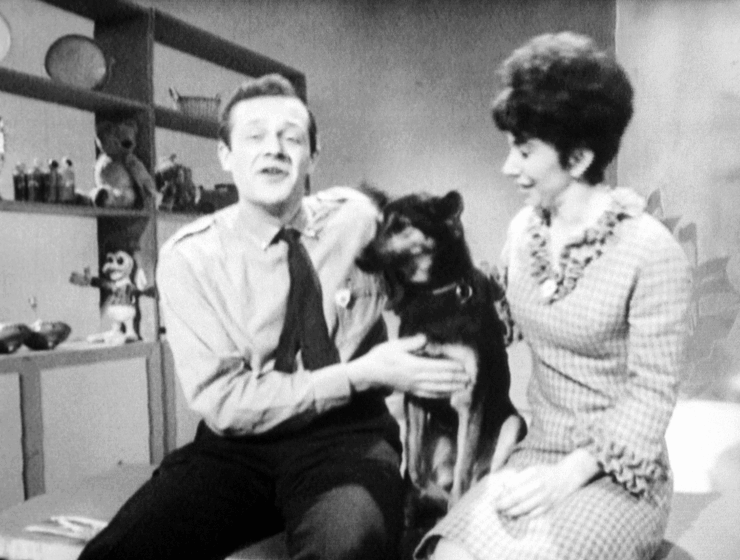
When viewed like this, it’s clear that the image manipulation went way beyond “shove Nicey in the picture in place of Petra”:
- Most obviously, the gap between Chris and Val has been widened to fit Nicey in.
- The left hand part of the picture with Chris, and the right half with Val, are actually from different parts of the same link. This is to make sure neither of them are speaking while Nicey is.
- To give even more time for Nicey’s lines, Chris rubbing and patting Petra has been looped, so it happens twice. This is obvious if you’re specially looking for it, but I never noticed it on endless watches.
- Finally, Chris’ final line is different. In End of an Era, he responds to Nicey at the end by saying “You’re welcome!” In the original link, he says “Well, you know…”6
Of all the pieces of image manipulation in End of an Era, I think the above is my favourite. It’s technically brilliant, but still used to serve a joke rather than nonsense for its own sake. The fact this was done in 1994 blows my mind. It would be an incredible piece of work using technology from three decades later.
But wait, we’re not done with Blue Peter yet…
(6:58) Blue Peter • BBC TV • TX: 14th October 1963
Ah, the joys of television research. The paperwork for End of an Era lists precisely one episode of Blue Peter; the Freddie and the Dreamers episode above. But hang on a minute, something here doesn’t match:
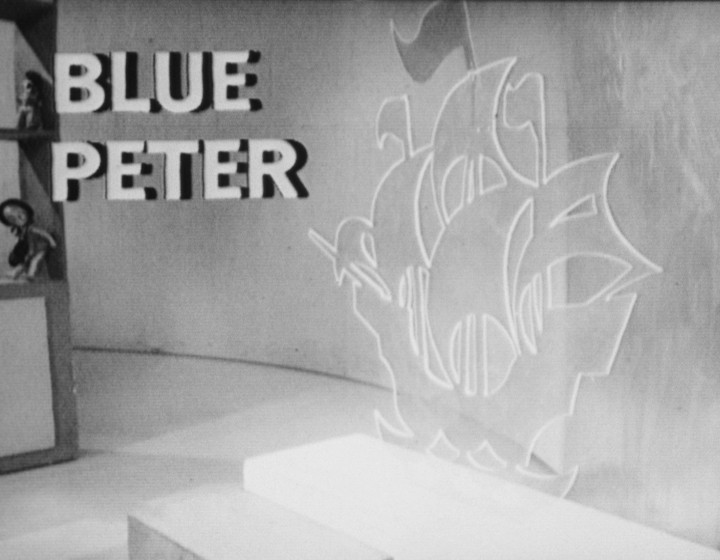
Blue Peter, 23rd March 1964
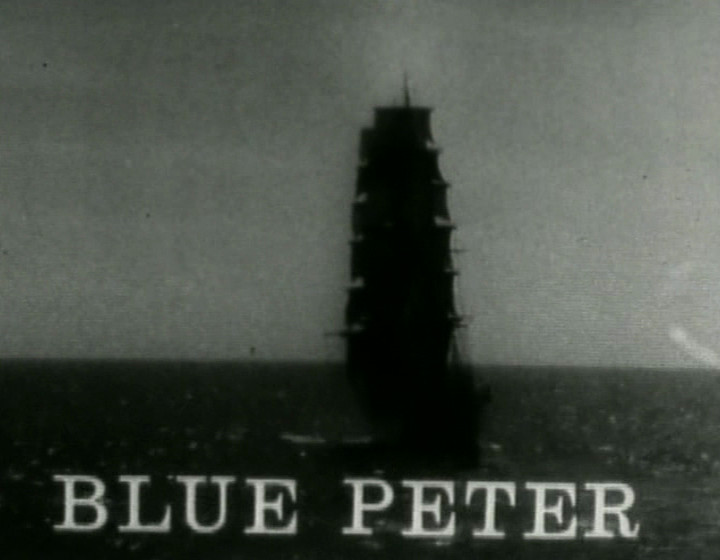
End of an Era
Yes, the Blue Peter title sequence in End of an Era is completely different to the one actually used in the episode featuring Freddie and the Dreamers. Which means that there is a second, completely different episode of Blue Peter used, completely unmentioned in the paperwork!
You might think finding out which episode this material came from would be an impossible task. And yet we are helped in two respects: firstly, huge chunks of the early years of the show are missing from the archives, including no complete editions from the first five years. This means there are far fewer episodes to check than would otherwise be the case. Secondly, each recording of Blue Peter in the archives has slightly different visual artefacts.
The titles which appear in End of an Era are in fact the very original title sequence for the show, used in the first episode, and for years afterwards. In Richard Marson’s excellent book Blue Peter 50th Anniversary, they are described as follows:
“On 30 September 1958, cameraman John Turner filmed just over 15 seconds of the Blue Peter flag being lowered on the Cutty Sark at Greenwich. This footage was married with an aerial stock shot of a tall ship from the BBC film library, looped to make it long enough for the sequence. As well as the theme, ‘Barnacle Bill’, Hunter Blair would always instruct sound to ‘add seawash’ as these titles were played out.”
As no episodes from the first few years of the show exist in the archives, this original title sequence is only preserved on a few existing episodes from 1963; as far as I can gather, this title sequence stopped being used from 1964 onwards. This title sequence is present on the episodes from the 14th October, 11th November and 9th December.
Let’s compare all three:
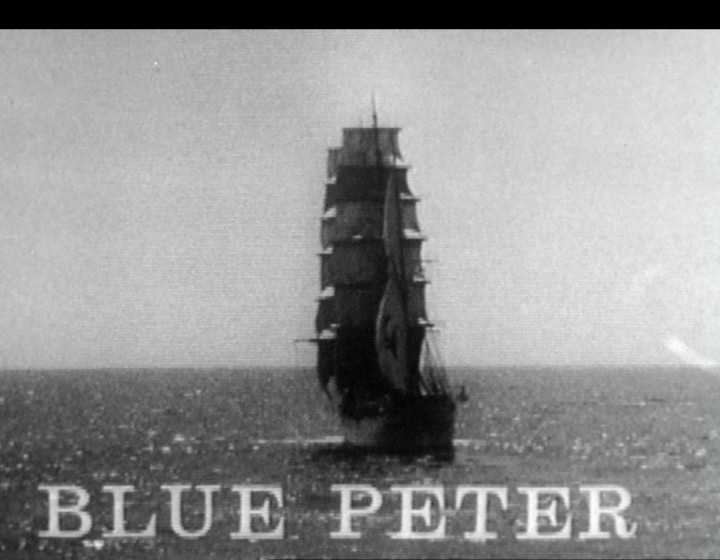
Blue Peter, 14th October 1963
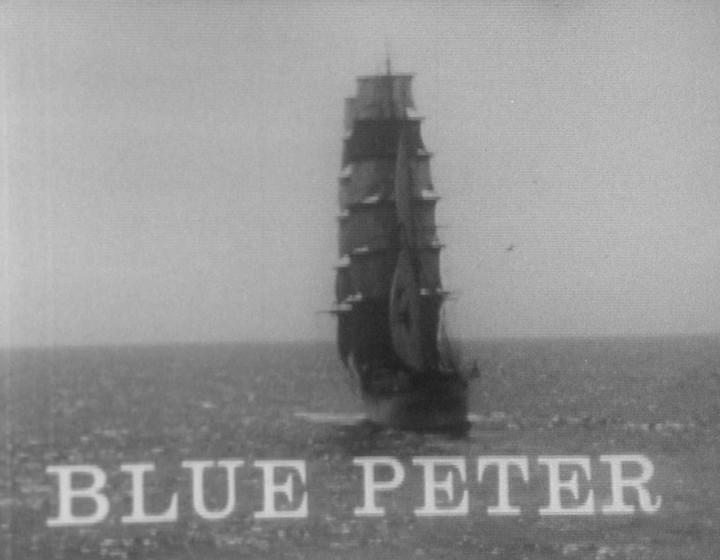
Blue Peter, 11th November 1963
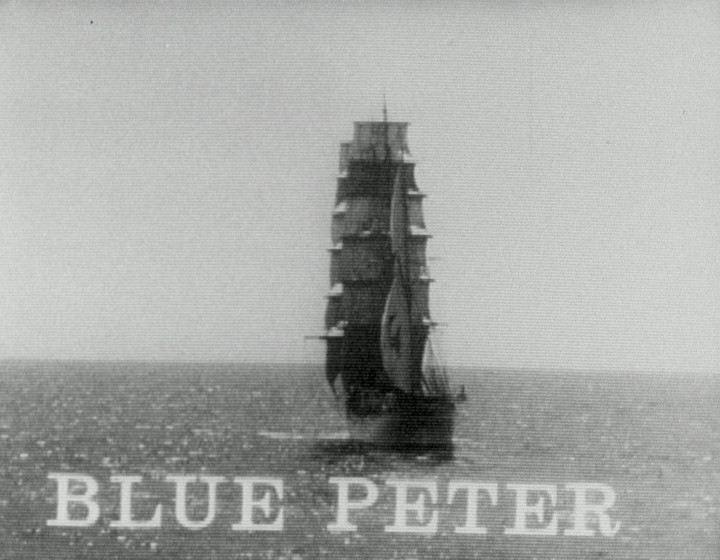
Blue Peter, 9th December 1963

End of an Era
Take a look at the right side of the picture, just above the horizon. The transfers are different, but there is an identical artefact of a white line, which is present in End of an Era and the 14th October 1963 episode, but missing from the other two. Meaning it’s almost certainly the episode End of an Era took these titles from.
Phew. I need a lie down now.
* * *
Secondly, onto The Beatles. This sequence is presented as one continuous clip, but this material originates from two entirely separate sources: the concert, and then the interview.
None of the above material appears in the extended VHS edit of End of an Era due to rights, which is possibly the most predictable bit of rights difficulties ever.
So, first off: where does the concert footage come from?
(8:32) The Mersey Sound • BBC TV • TX: 9th October 1963
The Beatles playing “Twist and Shout” comes from this 1963 BBC documentary, and in fact was specially shot for it. How do we know? Well, when it comes to The Beatles, there is only one authority to turn to: Mark Lewisohn. Sadly, his ongoing history The Beatles: All These Years hasn’t got to 1963 yet, but The Complete Beatles Chronicle (1992) tells us everything we need to know. The Beatles’ contributions to this documentary were shot between Tuesday 27th – Friday 30th August.
Lewisohn:
“From Tuesday through to Friday, the Beatles filmed a number of contributions to a 30-minute sociological documentary being made by Manchester-based BBC TV producer Don Haworth, aiming to capture the essence and atmosphere of the “Mersey Beat” boom. After initial talks with Brian Epstein, Haworth had met the Beatles on the 21 July and discussed the production, promising them the opportunity, which they certainly desired, of being able to discuss themselves more seriously than in the somewhat flip fashion typical of the usual pop TV programmes. After a meeting with Epstein on 6 August, Haworth duly captured the Beatles’ contract, which also precluded them appearing in Beat City, an equally thorough, though perhaps not as serious, rival documentary on the subject being made at the same time by ITV company Associated-Rediffusion.”
The only material from The Mersey Sound which appears in End of an Era is the “Twist and Shout” performance:
“The Beatles’ first filming took place from 9.30am on Tuesday 27 August. Requiring live action footage of the group, yet aware of the enormous difficulties filming amid the bedlam of an actual live Beatles concert, Don Haworth booked time at the Little Theatre in Hogoton Street, Southport, where the group played on stage without an audience. The film was then intercut with hysterical audience footage shot the previous night at the Beatles’ Odeon show.7 This morning the Beatles performed ‘Twist and Shout’ and ‘She Loves You’, dressed in typical-of-the-day grey collarless suits.”
The entire documentary is on the Internet Archive, and is well worth a watch.8 If we compare the performance of “Twist and Shout” used in the full programme to that included in End of an Era, we can spot a couple of differences:
These changes were surely made by End of an Era itself, in order to make the shortened clip work better in context. Firstly, the opening shot of John Lennon is replaced with a group shot of the band, in order to better establish the subject of the clip quickly. Secondly, a repeated shot of Paul McCartney is replaced with a different shot of Paul and George.9 In the context of a longer sequence, the duplicate shot works; in the shortened clip that End of an Era uses, it would simply have given too much focus on Paul.
The above changes are one of my favourite things I’ve found out while writing this article, despite being small in the grand scheme of things. Sure, the Blue Peter clips are both showy and extremely amusing. But the above changes prove End of an Era‘s commitment to telling its story clearly and concisely, and that’s just as important if you’re trying to sell the mockumentary aspect of the programme properly.
And finally, what about when Nicey actually met the Beatles?
(8:44) Day by Day • Southern • TX: 12th November 196310
Ah, Nicey interviewing The Beatles… and trying to get a date with Paul McCartney. This is one of the very rare pieces of non-BBC footage in End of an Era; Day By Day was Southern’s local news programme.
Unfortunately, a high quality version of the original footage has proved impossible to find in the wild; End of an Era has by far the highest quality version of this footage generally available. A low quality version does exist on the Internet Archive, which I’ve replicated below for ease of viewing.11
Again, a video comparison doesn’t really do us much good in this case, but the following should suffice to give us an idea:
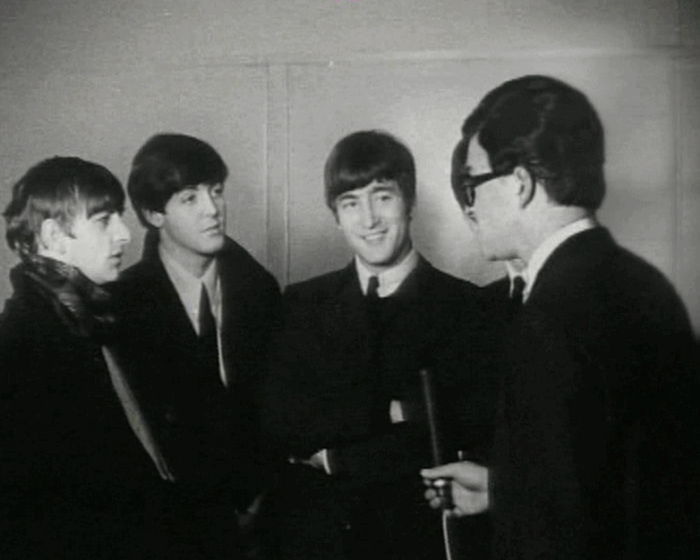
One notable thing is that all the cutaways to the close-up of Nicey are brand new in End of an Era, adding a piece of visual language completely absent in the original clip. But the real magic is the addition of two simple sound effects: an extremely camp “Oooooh!” from Lennon, and some awkward whistling from Paul. Both additions are perfect; they’re not working against the material, but really do seem to match what’s happening on-screen. These two additions do an incredible amount of work in selling the story that Nicey’s dialogue is setting up.
The big question surrounding this interview is: why exactly does Paul McCartney behave so oddly in it, almost hiding in the shadows at points? Was he genuinely having issues with the real interviewer, Jeremy James?
The answer is something rather more prosaic. Back to Lewisohn:
“Hampshire’s teenage population went into veritable mourning when a gastric flu virus hit Paul McCartney and caused postponement of the Beatles’ Portsmouth shows this evening. They were soon re-scheduled for Tuesday 3 December, however.
Not postponed but cancelled (that is, never re-arranged) was a mimed musical appearance on the Southern Television programme Day By Day, scheduled to have been taped during the early afternoon at the company’s studios and transmitted this evening, 6.05 – 6.45pm. Instead, in the Guildhall dressing-room, they gave a short interview to reporter Jeremy James which was broadcast in the same programme.”
Paul is acting odd because he nearly shat and/or vomited over himself. That’s showbusiness. As is End of an Era exploiting Paul’s discomfort mercilessly.
The big question is: how the bloody hell did Enfield and Whitehouse even know about this interview? It’s not exactly a well-known piece of Beatles footage, especially before End of an Era used it.
* * *
Still, if we don’t know the above, we can at least guess about how some of the material in the show was discovered.
On the 5th October 1991, the first episode of Sounds of the Sixties aired on BBC2. This seminal series marked a new high in the BBC intelligently making use of its archive; it’s hard not to view programmes like …at the BBC that we have today as having their roots in what BBC2 was doing in the early 90s.
And what exactly was in that first episode? Not only does it feature the Blue Peter performance of Freddie and the Dreamers singing “You Were Made for Me”, but it also features footage of The Beatles from The Mersey Sound.12 Sure, it’s their performance of “She Loves You” rather than “Twist and Shout”, but the link is obvious.
It is, of course, so tempting to imagine Enfield and/or Whitehouse watching the show back in 1991… and formulating plans. That idea makes me tingle slightly. But it could also simply be that when they were researching End of an Era, they called up a load of material for research, and Sounds of the Sixties was part of that. Either way: in an article which is going back to see where the material for End of an Era originally came from, noting what appears to be an important source for the discovery of said material seems worthwhile.
And we’re just getting started. Next up: a look at Smashie’s cop-tastic acting roles. More next time.
With thanks to Darrell Maclaine and Mike Scott for various bits of inspiration (and occasionally just copying their points verbatim), Stephen Neal for technical checks, Richard Marson for Blue Peter advice, Milly Storrington for archive help, and Tanya Jones for being my unpaid editor.
Mere text cannot quite convey how Harry Enfield pronounces this word. ↩
The paperwork erroneously gives the year as 1963, but this is a typo; there was no episode of Blue Peter broadcast on that date, and “You Were Made For Me” hadn’t been released by March 1963 anyway. ↩
All audio is taken from the original Blue Peter clip. You will also note that at 1:23, there seems to be more frames present in the End of an Era clip than in the Blue Peter footage. These were probably chopped out due to picture damage; it is a pretty dodgy transfer. ↩
There is one thing the clip doesn’t quite get right. Note how Nicey’s dancing is smoother than the rest of the action? It’s not that distracting, but it’s not quite right, is it?
The reason for this is technical. The look of Blue Peter on original transmission would have been smooth video motion. However, the programme only survives as a telerecording on film, which folds the temporal resolution down by half. Nicey’s section was shot on video, however, so when the two are married together, it has the slightly unfortunate effect of Nicey appearing to move more smoothly than the surrounding footage.
Elsewhere in End of an Era, the extra material has been treated to match the same frame rate as the film, but here, for whatever reason, it wasn’t. This isn’t nearly as annoying as it could have been in practice, but it is technically wrong. ↩
I deliberately degraded the frame from End of an Era in order to match the other footage more closely. ↩
The obvious question is: where did End of an Era manage to find an audio clip of Christopher Trace saying “You’re welcome”, presuming it is actually him, and not somebody else’s voice? Alas, finding this out has proved beyond me. It certainly isn’t in the 23rd March episode. If you have any idea, send an SAE to DIRTY FEED RESEARCH APPEAL, BBC Television Centre, London W12. ↩
MORE BBC FAKERY, DEFUND THE BBC. ↩
There is also a version on YouTube, but it has a few changes made to it in order to bypass YouTube’s copyright filters. ↩
Both these shots are taken from later in the performance, in a section End of an Era doesn’t otherwise use. ↩
Here’s an odd little research wrinkle: this material isn’t listed as Day By Day in the paperwork for End of an Era. Instead, it’s labelled as “Southern Inject / Jeremy James inter. with the Beatles”. Southern is clearly referring to the TV company, but “Southern Inject” is odd phrasing I’ve not heard elsewhere. For a while it put me on the wrong track, as I thought that was the title of the TV show. Do they essentially mean “injection point”, with Southern material being played down the line for the Beeb to record? ↩
The cropped nature of the below clip highly suggests it was originally a copy with burnt-in time code, escaped from the archive through some nefarious means. ↩
Sadly muted in that YouTube clip so it won’t trip the copyright filters. ↩

13 comments
Zoomy on 17 March 2024 @ 1pm
Thank you for this! The sheer cleverness and complexity of that Blue Peter bit is something you just don’t consider until someone points it out!
Gareth Randall on 17 March 2024 @ 3pm
I suspect that the Quantel Henry was used for the compositing, which would have made it a very expensive proposition – Henry time was typically billed at £800 an hour a decade later, and in 1994 it was still so new and high-end that only gold-plated Soho facilities houses would have had it.
I’ve never previously clocked the obvious loop in the stock footage of the ship in the BP titles, with the bird suddenly reversing direction. And it’s interesting that in the Freddie & the Dreamers edition of BP, the director didn’t respond to Petra deciding to wander out of shot by starting the camera move earlier, but stuck with the empty frame until the preplanned bar of the music.
John J. Hoare on 17 March 2024 @ 4pm
Zoomy: you’re welcome, thank you!
Gareth: Hah, yes, I meant to mention the bird bit myself as it’s amazing, and completely forgot!
It does seem likely that it was a Henry, doesn’t it? I was wondering whether Harry could do it, but in 1994 perhaps a Henry was more likely, when talking about something this complex. I would like to get some interviews with the production team about it really.
Will Tudor on 18 March 2024 @ 8am
Wonderful piece, yet again. That Blue Peter clip is hard-wired into my head thanks to countless viewings of SOTS and the End Of An Era version. I remember being amazed at the time and I still am now.
Regarding the “you’re welcome”, is it possible that Christopher said it in the edition used for the title sequence?
John J. Hoare on 18 March 2024 @ 11am
Cheers Will. I did actually check the 14th October edition while researching, because yes, that would have been an amazing link. No dice, sadly, and at that point I thought I was toppling down the rabbit hole a little too much…
Gareth Randall on 18 March 2024 @ 1pm
It’s not impossible that it was Harry, but it’s very hard to find detailed info these days on what Harry could do. It dated from 1985 and I’ve been told by a veteran editor that it only worked at frame rate, not field rate, which, if correct, suggests that it wasn’t used on EOAE given the field/frame mismatch in the BP sequence.
Gareth Randall on 18 March 2024 @ 5pm
I’ve found out that the VFX were done at Framestore, who had a Henry. Tim Webber did the work, and went on to do the Jack Dee John Smiths adverts and the Blackcurrant Tango ad and win an Oscar for the movie Gravity.
John J. Hoare on 18 March 2024 @ 5pm
Cheers Gareth. Him and David Cassidy – credited as “bluescreen technician”, an unusual credit for a TV show in 1994 – are the two I probably need to approach.
Smylers on 18 March 2024 @ 6pm
Wow, that Blue Peter editing is so impressive, now you point it out! Thank you for the interesting article.
It intrigues me that when programmes feature fictionalized versions of older programmes, sometimes the programme’s real name is used and sometimes it isn’t. So in ‘End of an Era’, ‘Blue Peter’ is indeed called ‘Blue Peter’. But, for instance, in a recent episode of ‘Sister Boniface Mysteries’ that featured a 1960s nautical-themed kids magazine TV show (with 3 presenters, activities including crafts, baking, and stunts, and badges awarded to viewers), it was called ‘Jolly Roger’.
Anyway, any fans of pastiche 1960s children’s TV who haven’t already seen it may enjoy: https://uktvplay.co.uk/shows/sister-boniface-mysteries/series-2/episode-1/6327325355112
Andy Currington on 19 March 2024 @ 9am
“Well, when it comes to The Beatles, there is only one authority to turn to: Mark Lewisohn. Sadly, his ongoing history The Beatles: All These Years hasn’t got to 1963 yet, but The Complete Beatles Chronicle (1992) tells us everything we need to know”
Hang on. This guy’s been writing about The Beatles for over thirty years, but his ongoing history hasn’t even reached 1963? And they say their fans obsess over too much detail.
Nathan on 28 March 2024 @ 3pm
I had to stop and relisten, as I couldn’t believe how GOOD that Freddie & The Dreamer clip sounded! I’ve always preferred the ‘Blue Peter’ version of the song finding it far superior to the disc version, but to be able to hear it in high fidelity is fantastic!
Paul Bovey on 1 April 2024 @ 2pm
Brilliant stuff, John.
I don’t know whether it was intentional or not, but it’s very fitting character-wise that Nicey refuses to play We All Stand Together after failing to get a date with Paul McCartney in the 1963 Day By Day clip. I love the idea of him still holding a grudge over 20 years later.
John J. Hoare on 2 April 2024 @ 10am
Thanks all!
Second part of this article is delayed a bit due to various things – not least work – but I’ll try and get it done this month.
Comments on this post are now closed.